Computer Science > AQA QUESTION and MARK SCHEMES > AQA A-level COMPUTER SCIENCE 7517/2 Paper 2 Question Paper + Mark scheme [MERGED] June 2022 *JUN2275 (All)
AQA A-level COMPUTER SCIENCE 7517/2 Paper 2 Question Paper + Mark scheme [MERGED] June 2022 *JUN227517201* IB/G/Jun22/E16 7517/2 For Examiner’s Use Question Mark 1 2
Document Content and Description Below
AQA A-level COMPUTER SCIENCE 7517/2 Paper 2 Question Paper + Mark scheme [MERGED] June 2022 *JUN227517201* IB/G/Jun22/E16 7517/2 For Examiner’s Use Question Mark 1 2 3 4 5 6 7 8 9... 10 11 12 13 TOTAL Time allowed: 2 hours 30 minutes Materials For this paper you must have: • a calculator. Instructions • Use black ink or black ball-point pen. • Fill in the boxes at the top of this page. • Answer all questions. • You must answer the questions in the spaces provided. Do not write outside the box around each page or on blank pages. • If you need extra space for your answer(s), use the lined pages at the end of this book. Write the question number against your answer(s). • Do all rough work in this book. Cross through any work you do not want to be marked. Information • The marks for questions are shown in brackets. • The maximum mark for this paper is 100. Advice • In some questions you are required to indicate your answer by completely shading a lozenge alongside the appropriate answer as shown. • If you want to change your answer you must cross out your original answer as shown. • If you wish to return to an answer previously crossed out, ring the answer you now wish to select as shown. Please write clearly in block capitals. Centre number Candidate number Surname Forename(s) Candidate signature I declare this is my own work. A-level COMPUTER SCIENCE Paper 2 2 *02* IB/G/Jun22/7517/2 Do not write outside the box 3 Answer all questions. 0 1 . 1 Describe how a 12-bit unsigned binary integer such as 010010101110 can be converted directly into hexadecimal. The method you describe must not involve converting into decimal. [2 marks] 0 1 . 2 State one reason why hexadecimal is often used in preference to binary. [1 mark] 0 2 . 1 A data communications system uses parallel data transmission. Describe how parallel data transmission works. [2 marks] 3 *03* Turn over ► IB/G/Jun22/7517/2 Do not write outside the box 6 0 2 . 2 State one advantage of serial data transmission over parallel data transmission. [1 mark] 0 2 . 3 Shade one lozenge to indicate which of these statements about data communications systems is false. [1 mark] A For a particular communications channel, the bit rate can be higher than the baud rate. B Latency is the rate at which signals on a wire or line can change. C The bandwidth of a transmission medium is the range of signal frequencies that the medium can transmit without a significant reduction in signal strength. D The greater the bandwidth of a transmission medium the higher the bit rate that can be achieved by a communication system using it. 0 2 . 4 State the purpose of the start bit in asynchronous serial transmission. [1 mark] 0 2 . 5 State the purpose of the stop bit in asynchronous serial transmission. [1 mark] 4 *04* IB/G/Jun22/7517/2 Do not write outside the box 0 3 . 1 Complete the truth table in Figure 1 for the inputs A and B. [1 mark] Figure 1 ?? ?? ?? + ?? ??� ??� ??� ∙ ??� ?? � ��� ∙ �� ??�� 0 0 0 1 1 0 1 1 0 3 . 2 The truth table in Figure 1 demonstrates the correctness of an important law in Boolean algebra. State the name of the law. [1 mark] 5 *05* Turn over ► IB/G/Jun22/7517/2 Do not write outside the box 6 0 3 . 3 Using the rules of Boolean algebra, simplify the following Boolean expression. � A��� + B ������ ∙ � C + B �������� ⋅ �� C�� + C ⋅ (A + A� ∙ (B + 1)) You must show your working. [4 marks] Working Answer Turn over for the next question 6 *06* IB/G/Jun22/7517/2 Do not write outside the box 4 0 4 . 1 Define the term ‘system software’. [1 mark] 0 4 . 2 The list below contains five types of software. Four of the types are examples of system software. Shade one lozenge to indicate which type of software is not system software. [1 mark] A Assemblers B Bitmap image editors C Interpreters D Libraries E Utility programs 0 4 . 3 Describe two functions of an operating system. [2 marks] Function 1 Function 2 7 *07* Turn over ► IB/G/Jun22/7517/2 Do not write outside the box 0 5 . 1 Figure 2 shows a number stored using a fixed point representation and two’s complement, with six bits before and four bits after the binary point. Figure 2 1 0 1 1 0 0 1 0 1 1 Convert the number in Figure 2 to decimal. You should show your working. [2 marks] Answer 0 5 . 2 State two reasons why values stored using a floating point representation are usually stored in normalised form. [2 marks] Reason 1 Reason 2 Question 5 continues on the next page 8 *08* IB/G/Jun22/7517/2 Do not write outside the Questions 05.3 box , 05.4 and 05.5 use a normalised floating point representation with an 8-bit mantissa and a 4-bit exponent, both stored using two’s complement. 0 5 . 3 Figure 3 shows a floating point representation of a number. Figure 3 Calculate the decimal equivalent of the number. Express your answer as a fraction or to 4 decimal places. You should show your working. [2 marks] Answer 9 *09* Turn over ► IB/G/Jun22/7517/2 Do not write outside the Questions 05.3, 05.4 and 05.5 use a normalised floating point representation with an box 8-bit mantissa and a 4-bit exponent, both stored using two’s complement. 0 5 . 4 Write the normalised floating point representation of the decimal value –23.25 in the boxes below. You should show your working. [3 marks] Answer Question 5 continues on the next page 10 *10* IB/G/Jun22/7517/2 Do not write outside the box 11 Questions 05.3, 05.4 and 05.5 use a normalised floating point representation with an 8-bit mantissa and a 4-bit exponent, both stored using two’s complement. 0 5 . 5 Figure 4 shows the closest possible representation of the decimal number –0.22558594 in this floating point system. Figure 4 By converting this number back to decimal it can be seen that the actual value stored is –0.2265625 Calculate the relative error that has occurred when representing –0.22558594 You should show your working. Express your answer as a percentage to 2 decimal places. [2 marks] Answer 11 *11* Turn over ► IB/G/Jun22/7517/2 Do not write outside the Turn over for the next question box DO NOT WRITE ON THIS PAGE ANSWER IN THE SPACES PROVIDED 12 *12* IB/G/Jun22/7517/2 Do not write outside the box 0 6 Supermarkets often gather information about their customers and the purchases that they make. This information can be analysed by the supermarket and other companies for a range of purposes. Some of the information is collected at the checkout, where the identity of the person is read from a loyalty or payment card using RFID (radio-frequency identification) and a barcode reader is used to identify the products being purchased. By analysing the purchases that a shopper has made, it might be possible to identify such things as whether the shopper has children, is pregnant, or lives in a house with a garden. Other types of analysis might include the amount of money a customer spends, the times that they choose to shop at and the differences in shopping habits of different groups of shoppers. Describe the principles of operation of the hardware used to collect the information and discuss some of the ethical and legal issues that might arise as a result of the capture and processing of this data. In your answer you will be assessed on your ability to follow a line of reasoning to produce a coherent, relevant and structured response. [12 marks] 13 *13* Turn over ► IB/G/Jun22/7517/2 Do not write outside the box 12 14 *14* IB/G/Jun22/7517/2 Do not write outside the box 0 7 A network of zoos uses a relational database system to store information about the animals that they have so that they can be matched up with animals at other zoos in a breeding programme. Figure 5 shows the structure of the relations in the database. Figure 5 Zoo(ZooName, Town, Country) AnimalLocation(AnimalID, ZooName, DateArrived, DateLeft) Animal(AnimalID, IndividualName, Species, DateOfBirth, Sex) Match(AnimalFemaleID, AnimalMaleID, DateOfMatch, Successful) • The Zoo relation stores details of the zoos that participate in the breeding programme. Each zoo is uniquely identified by its ZooName. • The AnimalLocation relation identifies which zoos each animal has lived at. The zoo that the animal is currently at can be identified because the DateLeft attribute is set to 01/01/0001 to indicate that the animal has not left. • The Animal relation stores details of the individual animals that are available to be matched with other animals for breeding. Each animal is identified by a unique number, the AnimalID. The individual name of the animal (eg ‘Timothy’) is also stored, together with the species of the animal (eg ‘Red Panda’), its date of birth and its sex (‘Male’ or ‘Female’). • The Match relation stores details of matches that have been made. The attributes AnimalFemaleID and AnimalMaleID refer to the AnimalID values of the two matched animals in the Animal relation. 0 7 . 1 Shade one lozenge to identify which of the properties below does not have to be true for a fully normalised database. [1 mark] A Each attribute in a relation is dependent on the primary key. B Each attribute in a relation is dependent only on the primary key; it is not also dependent on any other attribute in the relation. C The primary key in each relation consists of only one attribute. D There are no repeating groups (or equivalently each attribute is atomic). 15 *15* Turn over ► IB/G/Jun22/7517/2 Do not write outside the box 0 7 . 2 Figure 6 is an incomplete entity-relationship diagram for part of the database shown in Figure 5. Draw lines on Figure 6 to indicate the degree of the two relationships between the three entities shown in the entity-relationship diagram. [2 marks] Figure 6 0 7 . 3 Complete the following SQL statement to create the Animal relation, including the key field. [3 marks] CREATE TABLE Animal ( ) Question 7 continues on the next page 16 *16* IB/G/Jun22/7517/2 Do not write outside the box 0 7 . 4 Figure 5 is repeated below to help you answer Question 07.4 without having to turn back in the question paper. Figure 5 (repeated) Zoo(ZooName, Town, Country) AnimalLocation(AnimalID, ZooName, DateArrived, DateLeft) Animal(AnimalID, IndividualName, Species, DateOfBirth, Sex) Match(AnimalFemaleID, AnimalMaleID, DateOfMatch, Successful) There is a requirement to identify all of the red pandas that were present at the zoo called ‘Ashdale Park’ at any time between 01/04/2020 and 31/05/2020, inclusive. The animals might still be at the zoo or may have moved to another zoo. Write a query that will list all the red pandas that were at the zoo on any day between these dates. For each red panda on the list, the animal’s individual name and the date that the animal arrived at the zoo, and no other fields, should be listed. [7 marks] 17 *17* Turn over ► IB/G/Jun22/7517/2 Do not write outside the box 15 0 7 . 5 It is proposed that an additional attribute, ZooName, is added to the Animal relation. This will store the name of the zoo that currently has the animal. No other changes would be made to the database. Describe one advantage and one disadvantage of adding this new attribute to the relation. [2 marks] Advantage Disadvantage Turn over for the next question 18 *18* IB/G/Jun22/7517/2 Do not write outside the box 0 8 A student is setting up a small computer network in their house. The network will link together the laptops, desktop computers and mobile devices that belong to the people who live in the house. 0 8 . 1 Compare how peer-to-peer networking and client-server networking work. [3 marks] 0 8 . 2 Explain why a peer-to-peer system would be most appropriate to use in the house. [3 marks] 19 *19* Turn over ► IB/G/Jun22/7517/2 Do not write outside the box 9 0 8 . 3 When a person in the house uses the network to load a webpage it is likely that the Domain Name Server (DNS) system will be used. Describe the main purpose of the DNS system and how it works. [3 marks] Turn over for the next question 20 *20* IB/G/Jun22/7517/2 Do not write outside the box This table is included so that you can answer Questions 09.1 and 09.2 on page 21. Table 1 – Standard AQA assembly language instruction set LDR Rd, <memory ref> Load the value stored in the memory location specified by <memory ref> into register d. STR Rd, <memory ref> Store the value that is in register d into the memory location specified by <memory ref>. ADD Rd, Rn, <operand2> Add the value specified in <operand2> to the value in register n and store the result in register d. SUB Rd, Rn, <operand2> Subtract the value specified by <operand2> from the value in register n and store the result in register d. MOV Rd, <operand2> Copy the value specified by <operand2> into register d. CMP Rn, <operand2> Compare the value stored in register n with the value specified by <operand2>. B <label> Always branch to the instruction at position <label> in the program. B <condition> <label> Branch to the instruction at position <label> if the last comparison met the criterion specified by <condition>. Possible values for <condition> and their meanings are: EQ: equal to NE: not equal to GT: greater than LT: less than AND Rd, Rn, <operand2> Perform a bitwise logical AND operation between the value in register n and the value specified by <operand2> and store the result in register d. ORR Rd, Rn, <operand2> Perform a bitwise logical OR operation between the value in register n and the value specified by <operand2> and store the result in register d. EOR Rd, Rn, <operand2> Perform a bitwise logical XOR (exclusive or) operation between the value in register n and the value specified by <operand2> and store the result in register d. MVN Rd, <operand2> Perform a bitwise logical NOT operation on the value specified by <operand2> and store the result in register d. LSL Rd, Rn, <operand2> Logically shift left the value stored in register n by the number of bits specified by <operand2> and store the result in register d. LSR Rd, Rn, <operand2> Logically shift right the value stored in register n by the number of bits specified by <operand2> and store the result in register d. HALT Stops the execution of the program. Labels: A label is placed in the code by writing an identifier followed by a colon (:). To refer to a label the identifier of the label is placed after the branch instruction. Interpretation of <operand2> <operand2> can be interpreted in two different ways, depending on whether the first character is a # or an R: • # – use the decimal value specified after the #, eg #25 means use the decimal value 25 • Rm – use the value stored in register m, eg R6 means use the value stored in register 6 The available general-purpose registers that the programmer can use are numbered 0–12 21 *21* Turn over ► IB/G/Jun22/7517/2 Do not write outside the 0 9 Figure box 7 shows an assembly language program that has been written using the AQA Assembly Language Instruction Set, which is given in Table 1 on page 20. Figure 7 LDR R0, 120 LDR R1, 121 MOV R3, #0 loop: CMP R1, #0 BEQ exit AND R2, R1, #1 CMP R2, #0 BEQ skip ADD R3, R3, R0 skip: LSL R0, R0, #1 LSR R1, R1, #1 B loop exit: STR R3, 122 HALT 0 9 . 1 State the name of the addressing mode used in the instruction ADD R3, R3, R0 [1 mark] 0 9 . 2 Memory location 120 contains the value 23 and memory location 121 contains the value 5. Complete the trace table to show how the contents of the memory locations and registers change when the program in Figure 7 is executed. [5 marks] Memory locations Registers 120 121 122 R0 R1 R2 R3 23 5 22 *22* IB/G/Jun22/7517/2 Do not write outside the box 10 0 9 . 3 State the purpose of the program in Figure 7. [1 mark] 0 9 . 4 The program in Figure 7 has been written using assembly language. State two reasons why the programmer may have chosen to write this program in assembly language rather than in a high-level programming language. [2 marks] Reason 1 Reason 2 0 9 . 5 The program in Figure 7 will be translated into machine code. Explain the relationship between an assembly language instruction and a machine code instruction. [1 mark] 23 *23* Turn over ► IB/G/Jun22/7517/2 Do not write outside the box 1 0 . 1 A digital recording was made using a sampling rate of 44 100 Hz with a 16-bit sample resolution. A sampling rate of 1 Hz means that one sample has been taken every second. The file, which stores only the recording, is 17.199 megabytes in size. Calculate the duration of the recording in seconds. You should show your working. [3 marks] Answer seconds Question 10 continues on the next page 24 *24* IB/G/Jun22/7517/2 Do not write outside the box 6 3 1 0 . 2 MIDI is a system that can be used to enable musical devices to communicate and to represent music on a computer. Describe the advantages of using MIDI to represent music instead of using sampled sound. [3 marks] 1 1 Compare the hardware requirements of thin-client and thick-client computing systems. [3 marks] 25 *25* Turn over ► IB/G/Jun22/7517/2 Do not write outside the Turn over for the next question box DO NOT WRITE ON THIS PAGE ANSWER IN THE SPACES PROVIDED 26 *26* IB/G/Jun22/7517/2 Do not write outside the box 1 2 In a functional programming language, six functions named fu, fv, fw, fx, fy and fz and a list of temperatures in Fahrenheit named temps are defined as shown in Figure 8. Figure 8 temps = [50, 68, 95, 86] fu a = (a - 32) * 5 / 9 fv b = map fu b fw [] = 0 fw (x:xs) = 1 + fw (xs) fx [] = 0 fx (x:xs) = x + fx (xs) fy c = fx (c) / fw (c) fz d = fy (fv (d)) A temperature can be converted from degrees Fahrenheit to degrees centigrade using the following method: centigrade = (Fahrenheit – 32) × 5 9 For example, 59 degrees Fahrenheit is equivalent to 15 degrees centigrade. In the functions fw and fx: • [] is the empty list • (x:xs) lets the function definition refer to the head of the list as x and the tail as xs. 1 2 . 1 Shade one lozenge to indicate which of the listed functions from Figure 8 includes a higher-order function in its definition. [1 mark] fu fv fx fy 1 2 . 2 Shade two lozenges to indicate which of the listed functions from Figure 8 use recursion in their definitions. [1 mark] fu fv fw fx 27 *27* Turn over ► IB/G/Jun22/7517/2 Do not write outside the box 8 1 2 . 3 Calculate the results of making the function calls listed in Table 2, using the functions and list in Figure 8 as appropriate. [4 marks] Table 2 Function call Result fu 50 fv temps fw temps fz temps 1 2 . 4 Explain the purpose of the function fz. [1 mark] 1 2 . 5 It is proposed that the definition of the function fz is changed to: fz d = fu (fy (d)) Explain why this new definition of fz could be considered to be an improvement over the definition of fz in Figure 8 [Show More]
Last updated: 2 years ago
Preview 1 out of 64 pages

Buy this document to get the full access instantly
Instant Download Access after purchase
Buy NowInstant download
We Accept:

Reviews( 0 )
$7.00
Can't find what you want? Try our AI powered Search
Document information
Connected school, study & course
About the document
Uploaded On
Jun 03, 2023
Number of pages
64
Written in
Additional information
This document has been written for:
Uploaded
Jun 03, 2023
Downloads
0
Views
244

.png)
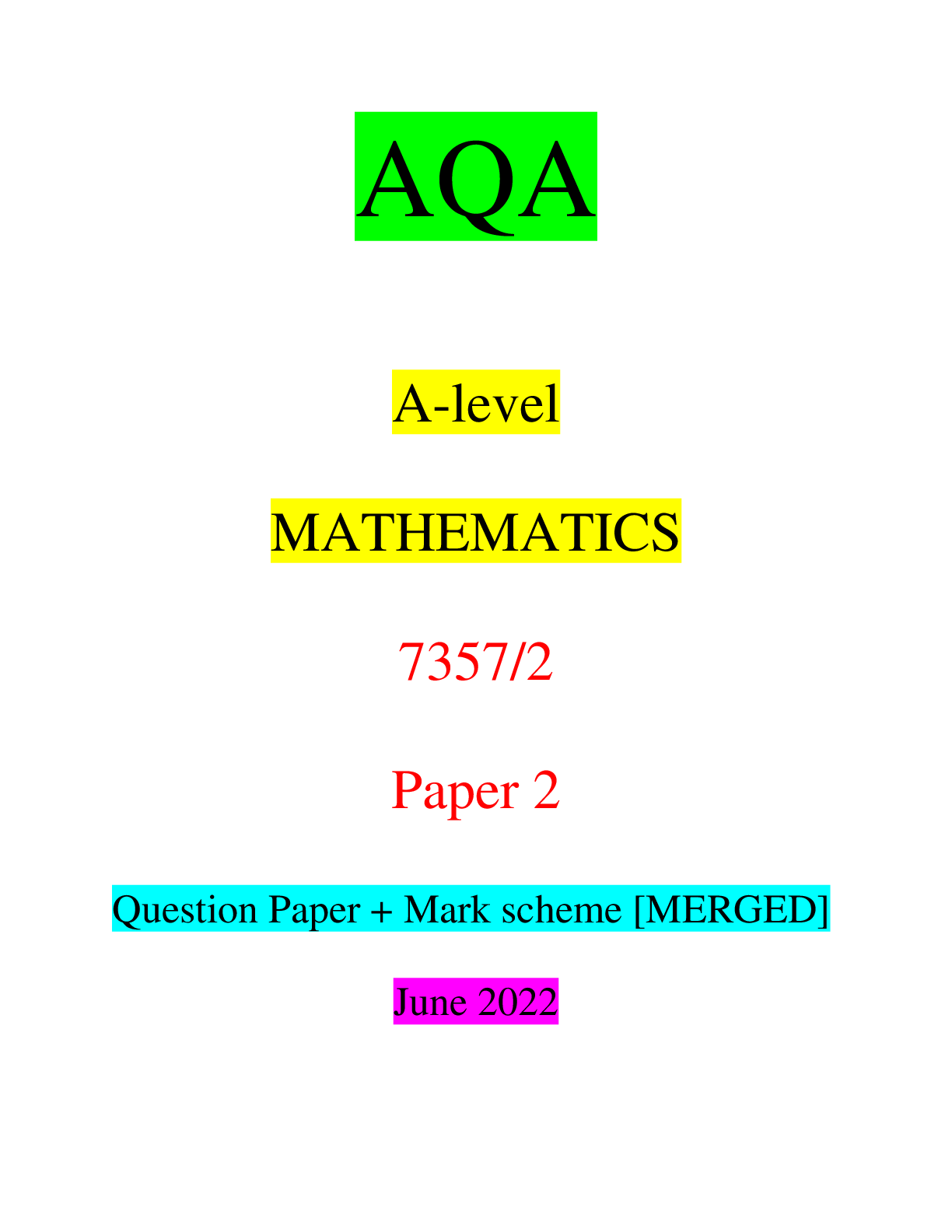


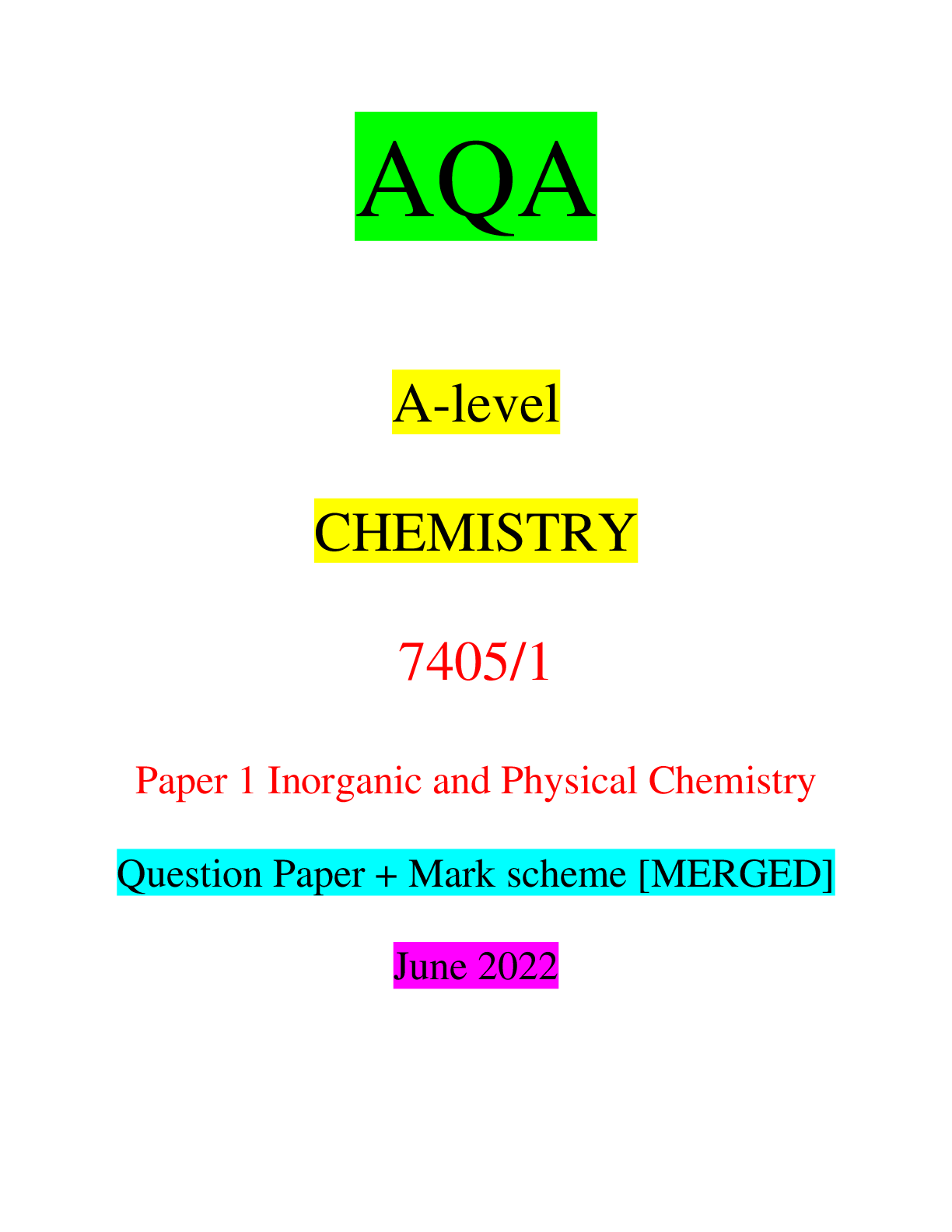
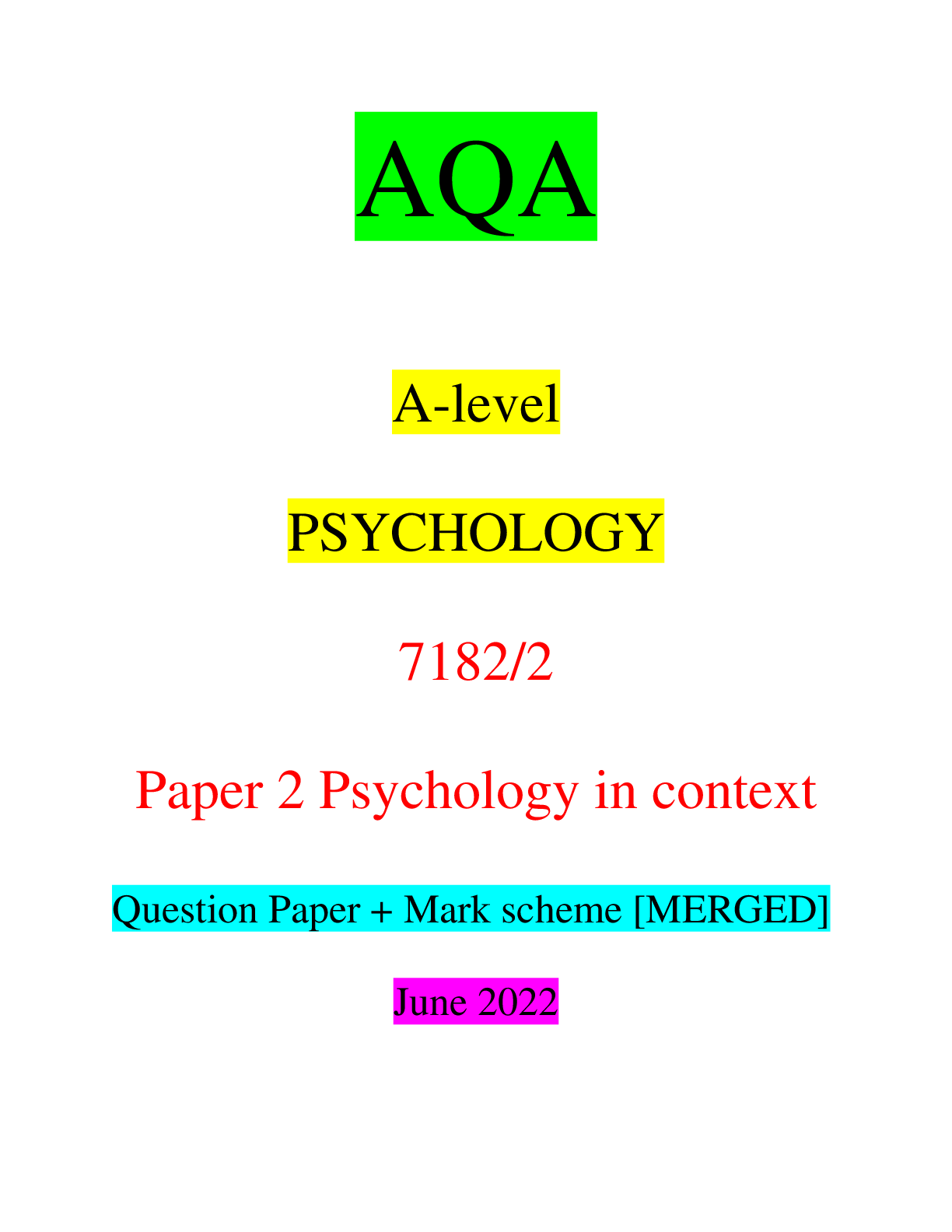
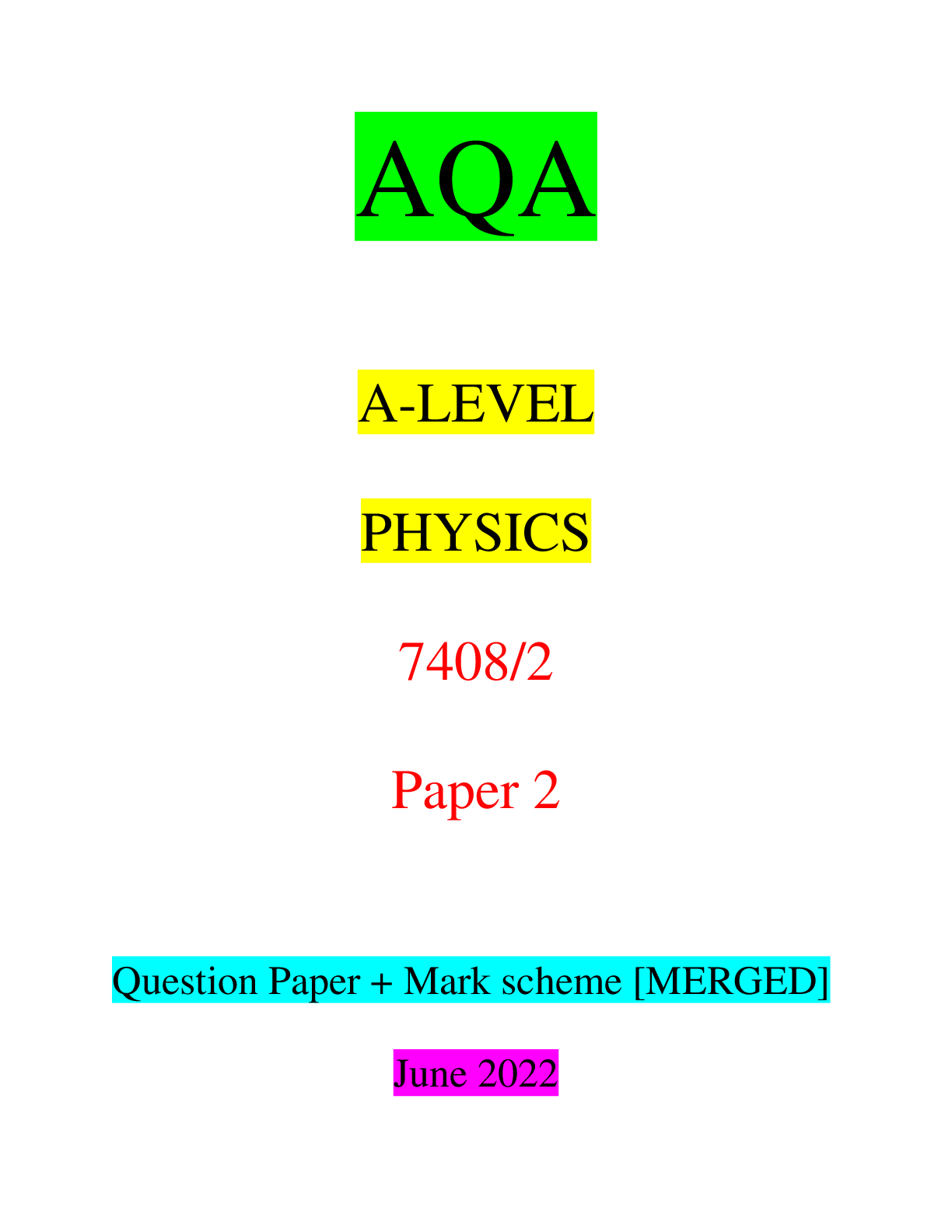

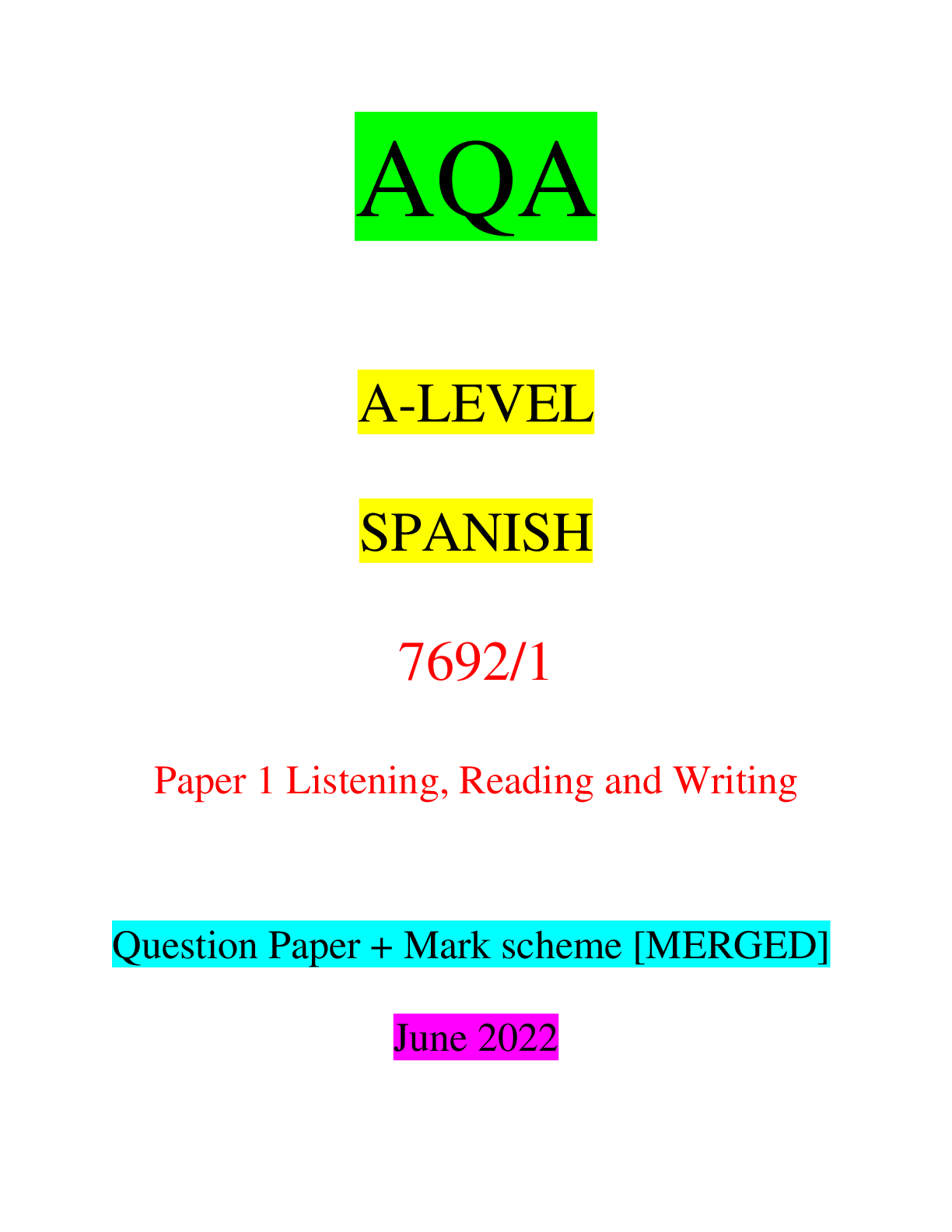

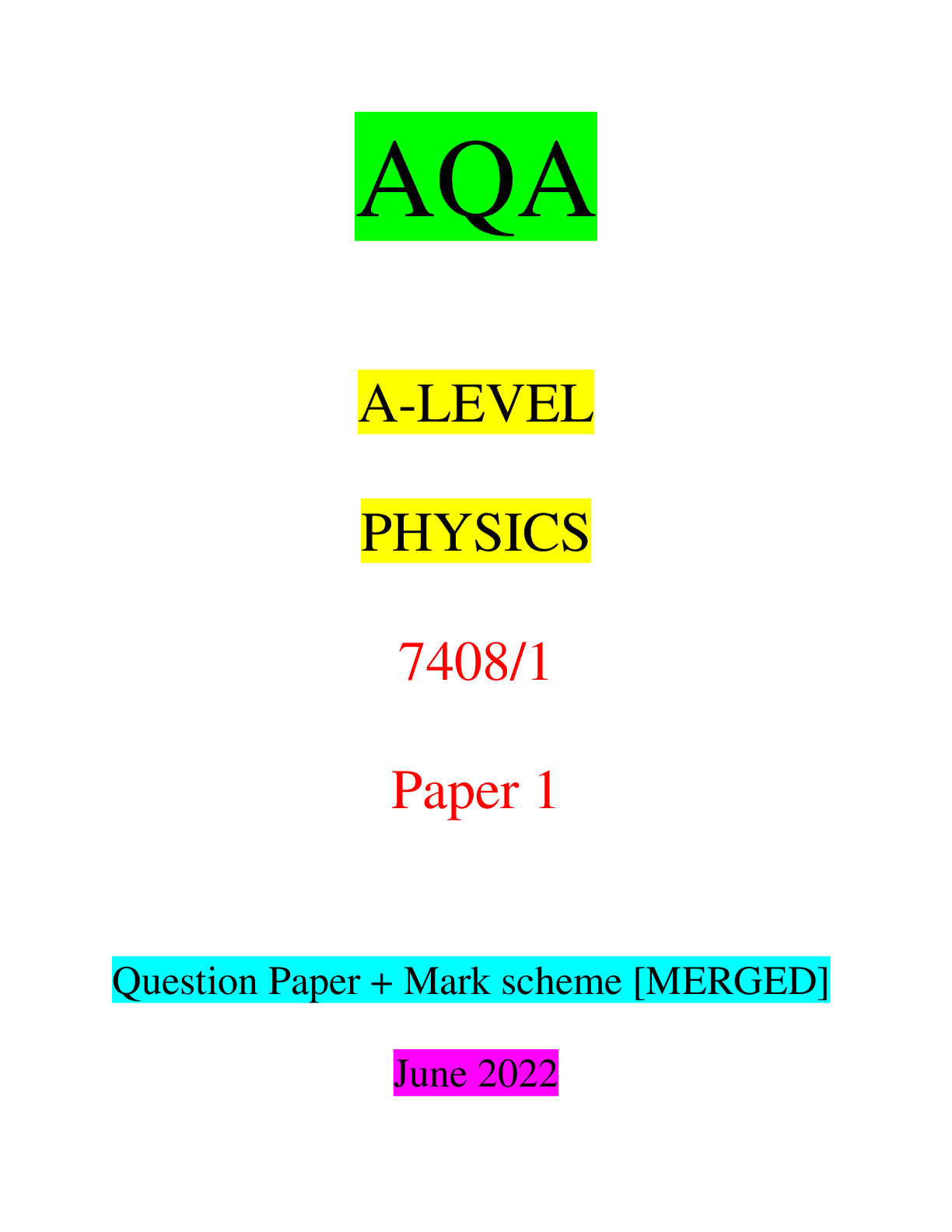
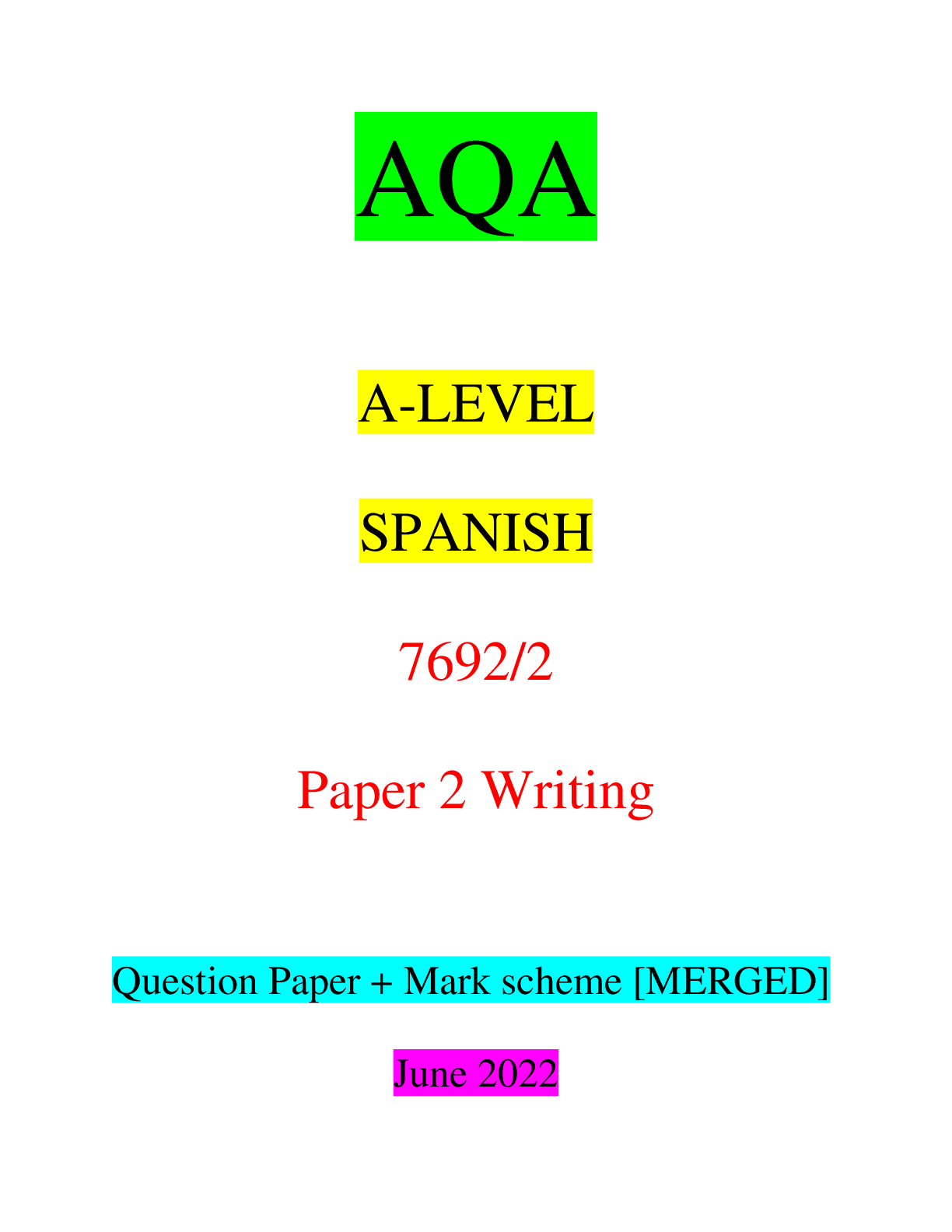
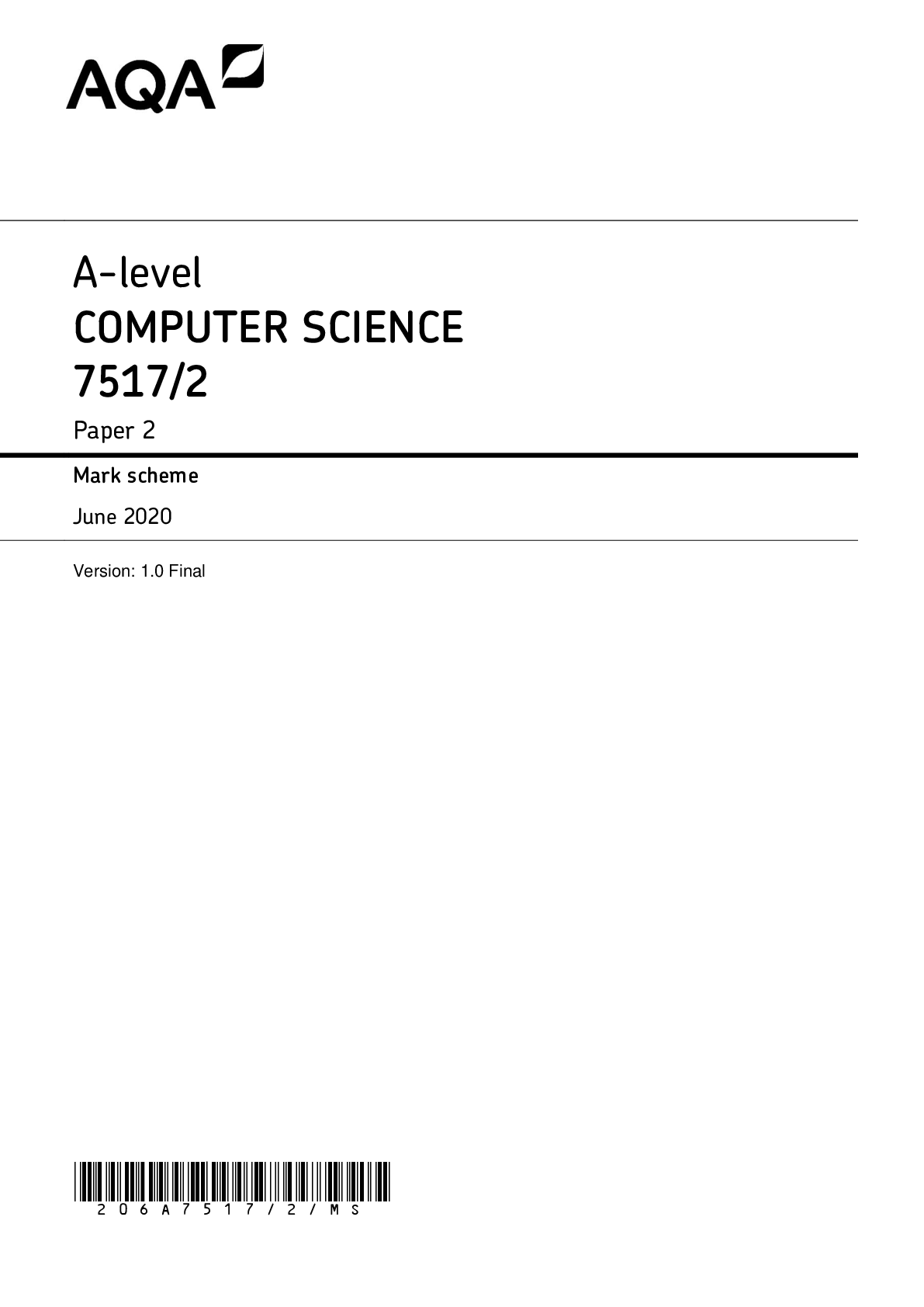
.png)
.png)
.png)
.png)
.png)
.png)
.png)
.png)
.png)
.png)

